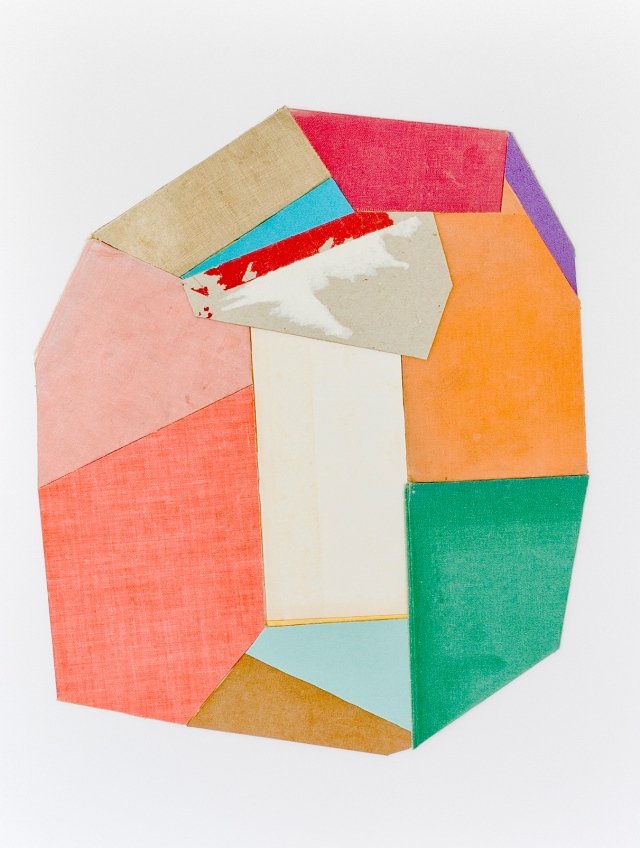Briefly describe the work you do.
I make abstract, geometric paintings and low-relief constructions; these often include materials that have fallen out of use such as water-damaged book covers or the parquet flooring of a derelict school.
At what point in your life did you want to become an artist?
I’ve never wanted to become an artist so much as just ‘make art a lot’. I remember just really loving drawing or rearranging objects to make a pattern. I got told off a lot for constant doodling at school so I suppose it has just always been a default setting of mine. I try and make a lot of room for it now, because I’ve realised how important and investigative all that drawing, note-jotting and experimentation really is.
Tell us a little about your background and how that influences you as an artist.
I grew up in an ex-council house on the South Coast of England with no money. This was great as we, (my brother, sister and I), had to be pretty creative in the absence of that conveyer-belt of plastic toys and computer games that a lot of kids have. For a while we had no phone, no car and no television licence but we always had lots of books and lots of kids to play with. I would make dens, draw, read and swim in the Sea in the summer. This kind of childhood definitely informs the work I make now. When I got to Chichester to study a BA in Fine Art, I found myself continually manipulating and reconfiguring materials that nobody else had noticed or wanted, and photographing objects or buildings that had an incidental patina or geometry, which I think came from a deeply felt appreciation for what was already around me.
What types of conceptual concerns are present in your work? How do those relate to the specific process(es) or media you use?
I would say that my practice is located somewhere between a lament and a celebration. This is expressed through my use of nostalgic materials, my use of colour and in the titles of the works. I use combinations of colour and texture in an intuitive, unfolding fashion. Usually I’m listening to music in the studio and a work will start to look like that song sounds, or it will remind me of a building or a person, a texture or memory of a particular summer, or the feeling of being submerged in water. It’s all pretty fluid and personal, but hopefully taps into something wider than that.
We once heard Chuck Close say he did not believe in being inspired, rather in working hard everyday. What motivates you in your studio practice?
I wouldn’t normally use this word, because it’s not very British, but I think I definitely experience periods of ‘flow’ in the studio when time becomes this gelatinous thing. However, I find you do actually have to turn up to work consistently to give yourself a good chance of this happening. I’m fortunate in that I feel quite restless when I haven’t been able to make work for a few days, so that’s a natural motivator.
What artists living or non-living influence your work?
Matisse, Ben Nicholson, Louise Bourgeois’ fabric works, Chris Johanson, Katja Strunz, I really like Vincent Hawkins’ finely judged use of meagre materials, Lygia Pape for her ‘Book of Time‘; there are so many.
When you are not making art what types of activities and interests do you engage in?
Visiting exhibitions, listening to music, watching films is a big one; recent favourites are Short Term 12 and Boyhood. Cycling to the woods near our house, Swimming in the Sea.
About
 Lauri Hopkins (b.1984) is a British Abstract Artist, living and working in Chichester in the UK.
Lauri Hopkins (b.1984) is a British Abstract Artist, living and working in Chichester in the UK.
Her work crosses disciplines but primarily involves painting, collage and the re-assembling of defunct materials. Inspiration is often drawn from music, mid-century Architecture and Design, the history of Abstract Art, objects that have fallen out of use and childhood memories.
Lauri has exhibited internationally since completing a BA in Fine Art from The University of Chichester in 2012. Her work has been selected for numerous National Art Competitions and has appeared in shows across the UK, Europe and the US. She has won awards for Best Exhibitor at Palace Art Fair, exhibited alongside artists such as Sean Scully, Luke Frost, Warren Isensee, Anna Kunz and Julie Torres. Avenir Magazine recently described her work as “timeless, elegant and unspeakably mesmerising”, citing Lauri as “one of the young rising stars of the contemporary art world”.
All images copyright of the artist and used with their permission.




